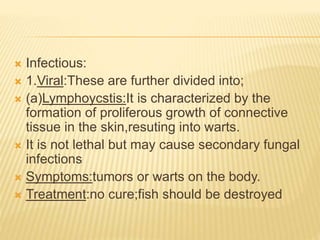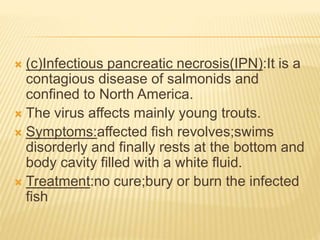Diseases of fishe
- 1. NAME: MUHAMMAD AAMIR BILAL SEMESTER: 7th ROLL NO: 35 PRESENTATION TOPIC: DISEASES OF FISH
- 2. Fish diseases may be infectious or non infectious Infectious includes; Viral borne Bacterial Fungal Trematodes Cestodes Nematodes etc.
- 3. Non Infectious includes; Anoxia Gas Bubble Disease PH disturbacnce Dietary Intoxications Toxic Algae
- 4. Infectious: 1.Viral:These are further divided into; (a)Lymphoycstis:It is characterized by the formation of proliferous growth of connective tissue in the skin,resuting into warts. It is not lethal but may cause secondary fungal infections Symptoms:tumors or warts on the body. Treatment:no cure;fish should be destroyed
- 5. (b)viral haemorrhagic septicaemia(VHS):this disease is mainly found in rainbow trout farm. It suddenly becomes chronic and mortality is very high. Symptoms:Usually kidneys and liver are affected;belly swells and foul smelling yellowish fluid is found in visceral cavity. Treatment:no cure
- 6. (c)Infectious pancreatic necrosis(IPN):It is a contagious disease of salmonids and confined to North America. The virus affects mainly young trouts. Symptoms:affected fish revolves;swims disorderly and finally rests at the bottom and body cavity filled with a white fluid. Treatment:no cure;bury or burn the infected fish
- 7. 2.Bacterial diseases:The bacterial diseases may be; (a)Dropsy:It a serious epidemic diseases,caused primarily by a becterium Aeromonas punctata. Symptoms: Accumulation of yellow or pink liquid in the body cavity. Fins are partly distroyed. Belly swells and fish look like a baloon Treatment: dip treatment in 5 ppm potassium permenganate solution is recommended.
- 8. (b)ulcer disease:this disease is common at brook trout hatcheries in USA. It is caused by a bacterium Hemophilus piscium. Symptoms:formation of open sores of ulcers:lesions appear as a small pimple;fin rays fall out. Treatment:chloromycetin is recommended as an effective control.copper sulphate treatment is also effective.
- 9. (c)vibriosis:it is common in estuaries and marine envoirnment.it is caused by Vibrio angullarium. These infections have been reported in freshwater salmonids recently in Norway. Symptoms:dull movements,loss of appetite,necrosis of kidney and bleeding at the base of fins. Treatment:oxytetracycline at a ratio of 50-70 mg/kg of body wt/day for 10 days is recommended.sufla drugs are also effective.
- 10. 3:Fugal disease:these may be; (a)Branchiomycosis:popularly known as ‘’gill rot disease”.It is caused by a genus Branchiomyces. This disease mainly occurs in hot weather.it is associated with rich organic matter such as dung,and bloom of planktonic algae. Symptoms:In late stages of the disease gill filaments decay and finally drop off;affected fish succumbs from suffocation. Treatment :bath treatment into 3-5% salt solution or in 5ppm of potassium permenganate sol recmnded.
- 11. (b)Icthyophonus disease:It is caused by Icthyophonus hoferi, a brownish yellow fungi. It attacks the internal organs of fish. Symptoms: fish loses equilibrium, mouth becomes open and rigid, tubling movements; death may take few months to many years. Treatment:no cure.
- 12. 4.Trematodes:it includes ; (a)clinostomiasis:these infects a wide variety of freshwater fishes and cause a disease called as ‘yellow grub’. Symptoms: small sized cream colored nodules are produced on body , head and fins; infecion does not cause serious disease. Treatment: no cure.
- 13. Non infectious diseases: these may be; (a).Anoxia: Mortality of fish due to anoxia is frequent problem in ponds of tropical countries. 5 ppm is considered as sufficient concentration. Conc less than 3 ppm may prove to be fatal. Possible measures:(1).fresh water should be added to the ponds. (2).thining of population of fish,removal of algal blooms.
- 14. .(b)PH concentration: If ph goes below causes acidemia. . normal range of ph is from 7-8. .Due to this disease fish perform rapid movements and a tendency to jump out of water. .treatment:powdered calcium carbide can reduce this problem.
- 15. (c):Intoxications : heavy metals such as zn,cu,Hg,Ni and Pb can enter into a pond or lake from industries. If water is hard with a ph of 8 so heavy metals ppts. But if water is soft with low ph,the metals in their ionic forms will prove toxic to fishes.















